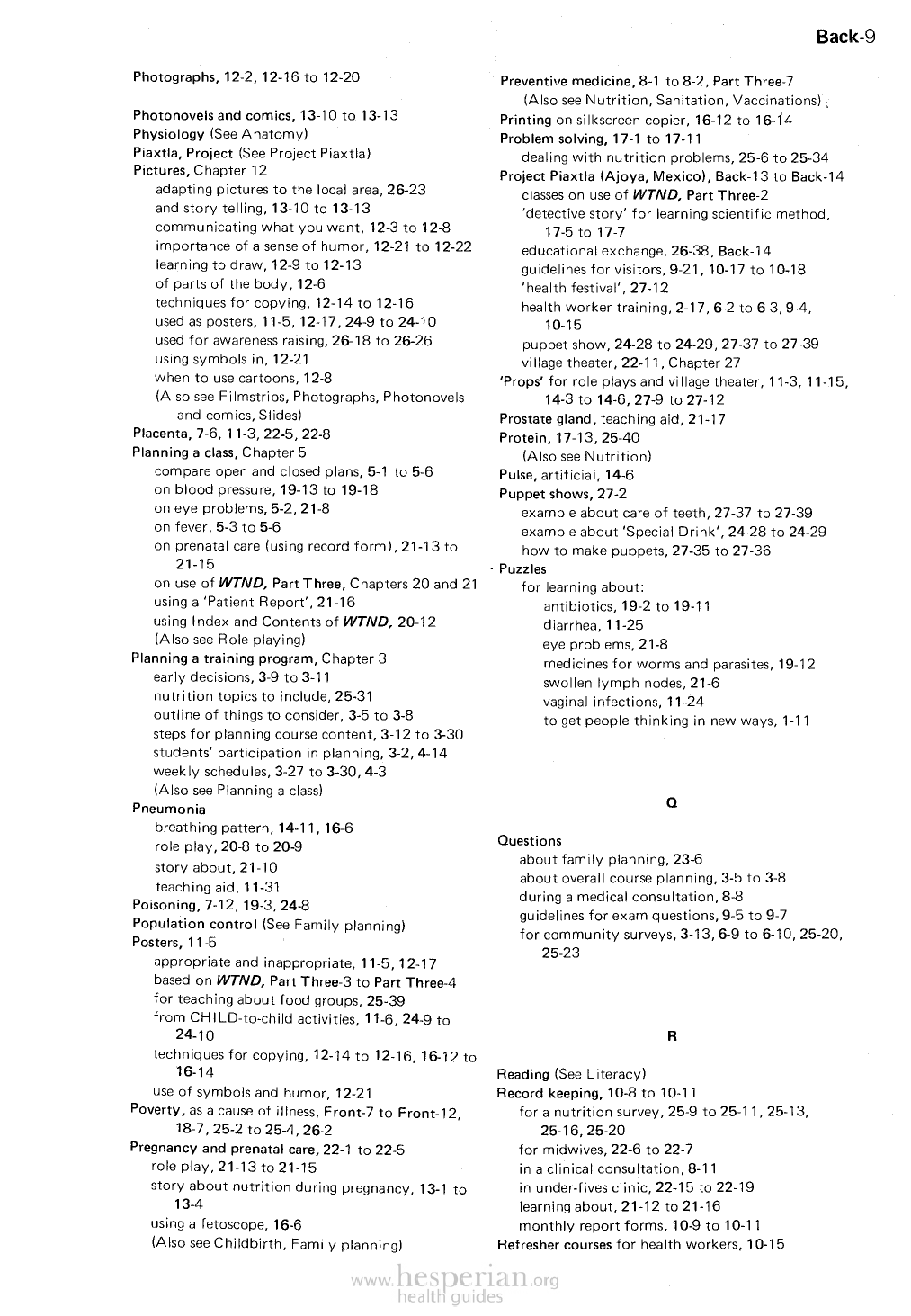
Back-9
Photographs, 12-2, 12-16 to 12-20
(Also see Filmstrips, Slides)
Photonovels and comics, 13-10 to 13-13
Physiology (See Anatomy)
Piaxtla, Project (See Project Piaxtla)
Pictures, Chapter 12
adapting pictures to the local area, 26-23
and story telling, 13-10 to 13-13
communicating what you want, 12-3 to 12-8
importance of a sense of humor, 12-21 to 12-22
learning to draw, 12-9 to 12-13
of parts of the body, 12-6
techniques for copying, 12-14 to 12-16
used as posters, 11-5, 12-17, 24-9 to 24-10
used for awareness raising, 26-18 to 26-26
using symbols in, 12-21
when to use cartoons, 12-8
(Also see Filmstrips, Photographs, Photonovels
and comics, Slides)
Placenta, 7-6, 11-3, 22-5, 22-8
Planning a class, Chapter 5
compare open and closed plans, 5-1 to 5-6
on blood pressure, 19-13 to 19-18
on eye problems, 5-2, 21-8
on fever, 5-3 to 5-6
on prenatal care (using record form), 21-13 to
21-15
on use of WTND, Part Three, Chapters 20 and 21
using a ‘Patient Report’, 21-16
using Index and Contents of WTND, 20-12
(Also see Role playing)
Planning a training program, Chapter 3
early decisions, 3-9 to 3-11
nutrition topics to include, 25-31
outline of things to consider, 3-5 to 3-8
steps for planning course content, 3-12 to 3-30
students’ participation in planning, 3-2, 4-14
weekly schedules, 3-27 to 3-30, 4-3
(Also see Planning a class)
Pneumonia
breathing pattern, 14-11, 16-6
role play, 20-8 to 20-9
story about, 21-10
teaching aid, 11-31
Poisoning, 7-12, 19-3, 24-8
Population control (See Faniily planning)
Posters, 11-5
appropriate and inappropriate, 11-5,12-17
based on WTND, Part Three-3 to Part Three-4
for teaching about food groups, 25-39
fromCHILD-to-child activities, 11-6, 24-9 to
24-10
techniques for copying, 12-14 to 12-16, 16-12 to
16-14
use of symbols and humor, 12-21
Poverty, as a cause of illness, Front-7 to Front-12,
18-7, 25-2 to 25-4, 26-2
Pregnancy and prenatal care, 22-1 to 22-5
role play, 21-13 to 21-15
story about nutrition during pregnancy,13-1 to
13-4
using a fetoscope, 16-6
(Also see Childbirth, Family planning)
Preventive medicine, 8-1 to 8-2, Part Three-7
(Also see Nutrition, Sanitation, Vaccinations) .
Printing on silkscreen copier, 16-12 to 16-14
Problem solving, 17-1 to 17-11
dealing with nutrition problems, 25-6 to 25-34
Project Piaxtla (Ajoya, Mexico), Back-13 to
Back-14
classes on use of WTND, Part Three-2
‘detective story’ for learning scientific method,
17-5 to 17-7
educational exchange, 26-38, Back-14
guidelines for visitors, 9-21, 10-17 to 10-18
‘health festival’, 27-12
health worker training, 2-17, 6-2 to 6-3, 9-4,
10-15
puppet show, 24-28 to 24-29, 27-37 to 27-39
village theater, 22-11, Chapter 27
‘Props’ for role plays and village theater, 11-3, 11-15,
14-3 to 14-6, 27-9 to 27-12
Prostate gland, teaching aid, 21-17
Protein, 17-13, 25-40
(Also see Nutrition)
Pulse, artificial, 14-6
Puppet shows, 27-2
example about care of teeth, 27-37 to 27-39
example about ‘Special Drink’, 24-28 to 24-29
how to make puppets, 27-35 to 27-36
Puzzles
for learning about:
antibiotics, 19-2 to 19-11
diarrhea, 11-25
eye problems, 21-8
medicines for worms and parasites, 19-12
swollen lymph nodes, 21-6
vaginal infections, 11-24
to get people thinking in new ways, 1-11
Q
Questions
about family planning, 23-6 about overall course
planning, 3-5 to 3-8 during a medical
consultation, 8-8 guidelines for exam questions,
9-5 to 9-7 for community surveys, 3-13, 6-9 to
6-10, 25-20, 25-23
R
Reading (See Literacy)
Record keeping, 10-8 to 10-11
for a nutrition survey, 25-9 to 25-11, 25-13,
25-16, 25-20
for midwives, 22-6 to 22-7
in a clinical consultation, 8-11
in under-fives clinic, 22-15 to 22-19
learning about, 21-12 to 21-16
monthly report forms, 10-9 to 10-11
Refresher courses for health workers, 10-15